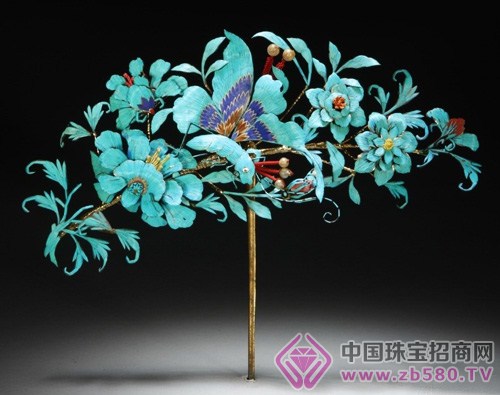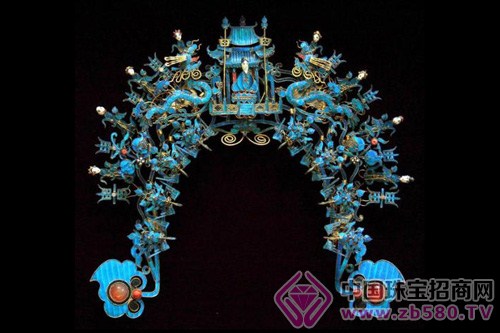"Reviewing the birth of Bi-color, shaking Yang Qingqing." Jin Yu Rong Rong, Qiao Cui Huagui, the past and the present, the Chinese have always liked to use the word "Cui" to describe women's gentle, handsome and delicate.
"Apricot blush is red and faint, Liu Mei Cui points to spring å¦", "Double 鬟 green drop, Jiaoyan 横 æ³¢ é»› é»› â€", "Heap pillow black cloud å • 翘 , , , , , , åˆ åˆ åˆ åˆ åˆ åˆ åˆ åˆ åˆ åˆ åˆ åˆ åˆ åˆ åˆ åˆ åˆ åˆ åˆBehind the word, it is not only the beautiful woman in the "speaking of the family, but also the emerald goldfish".
Talking about the "Cuiqiao Jinque", among them, the "point green" craft is the master of the gold jade jewelry skills.

"Dai Jincui's jewelry, adorned with pearls to sing the body." Unlike the Han and Tang Dynasties, using Cui Yu as a direct decoration of Jin Yuzhu, the "Dian Cui Craft" in the Ming and Qing Dynasties is the perfect combination of traditional metal craft and feather craft. As the leader of the traditional fine gold craft, it uses the complex crafts such as metalworking and Cuiyu as the content to create the scene of “Cuilu dark spot†and become the representative of Ming and Qing jewellery.
However, around the 1930s, the point jewellery was quietly extinct. From the court to the folk, the scene of “compressing the cross-cutting crests†is difficult, and the craftsmanship and technology of the jade jewelry have become a “difficult puzzleâ€.

The prosperity of the Ming and Qing Dian crafts
Different from the emerald's "Cui" bird's green color, "Jade" is not only refers to the emerald color, but also refers to Cui Yu. In a broad sense, as a traditional gold and silver jewellery making process, “Diancui†not only takes the name of the bird’s green color, but also means to take the “Jade Bird’s Feather†decoration, which is the use of the kingfisher’s feather as a jewelry. The auxiliary part is set on the metal to embellish and embellish the role of gold and silver jewelry.
In simple terms, the production process of Diancui is extremely complicated: it is necessary to first make the base of different craft patterns with metal of gold, silver, copper or gilt, and then cut the bright blue feathers of the back of the kingfisher and carefully inlay it. On the top, it is required to be flat and evenly exposed to make a point jade jewelry.
The jewellery made with the special technique of Dian Cui is extremely colorful and colorful, with good luster and colorful colors. This can be found in the picture of Yongzheng Twelve Beauty.
Summer butterfly, bamboo undercoat, Tongyin tea... The Chinese and American people wear the green scorpion, wearing a scorpion, the real school of the Qing Dynasty, the real painting of the jewellery, almost truly depicting the dressing of the Qing women and nobles. The activities and activities have effectively restored the different styles exhibited by the fashion trends at that time, especially the depiction of the costumes and jewellery in the paintings. The style of the fascinating tiara is unique and reveals the unique jewelry style in the middle of the Qing Dynasty.
In fact, the use of Cui Yu as a decorative history is very long, dating back to the Warring States Period, and the “Dian Cui†process of the Dacheng people reached its peak in the Ming and Qing Dynasties. In the story of "Han Feizi and the Foreign Reserves on the Left", the story of "buying 椟 椟 ç ç " was mentioned. The box called "Ji Yu Cui" should be decorated with kingfisher feathers. Cao Zhi's "Luo Shen Fu" is cloud: "Or pick pearls, or pick up Cui Yu." And "Political and Proof of Herbs" contains: "Fish dogs, today's kingfishers, there are sizes, small names, fish dogs, big ones. Ming Cui, take the tail as a decoration..."
Having said that, in terms of jewellery, unlike the ancient people who used Cui Yu as an ordinary decorative technique in the early period, the “Dian Cui†in the Ming and Qing Dynasties inherits and develops more complicated craft forms such as metal tires and point jade feathers. And gradually developed into a unique metalworking skills, and immediately became an important work in the production of gold and silver.

From the production process, the point jade jewelry can be roughly divided into three parts. The first is the carcass, which is a branch of the metal filament process, which is made of a metal carcass or a paper carcass, plus a filament process. After the carcass is finished, it is necessary to select a neatly-cut, suitable feather piece that is inlaid and pasted on the metal carcass, which is the most important part of the other jewelry. Finally, in the carcass and feathers, inlaid with gemstones, it is considered to complete the production of the whole piece of jewelry.
It is understood that the most difficult of these is the "point Cui Yu", which is the most essential part of the point jade jewelry. To this end, during the Ming and Qing Dynasties, the court used the emerald feathers of the kingfisher to make color matching. The Ministry of Internal Affairs of the Qing Dynasty specially set up the “Pico†to manage and collect the Cui Yu, while the “Silver Library†was specially set up with the “Point Cui†3 Name, specializing in the construction of "Cui live meter."
In the point jewellery, Cui Yu has the distinction of soft and hard, which is different in color and delicateness, and the craft and value are different. The hard green of the kingfisher's wings is easy to process, and its hardness is more suitable for making a piece of shape. It uses “cutting†and “stickingâ€, while the top one is called green velvet. It is the soft green of the back of the kingfisher. The color is bright, the texture is soft, the processing is difficult, the process is complicated and delicate, and the "point" method is often used.
The reason why the word "dot" is used to refer to this process is because it only refers to the process of patience and perseverance. It takes the soft and precious Cui Yu slowly to the small carcass. It is a superb technical activity, a slight deviation, even a slight hand shake, may have an impact on the final visual effect.
Because the point crafts not only involves the use of organic matter such as feathers, but also the production of point jade jewelry, in addition to the use of general techniques, must consider the adhesion of Cui Yu, including the composition and proportion of the adhesive. Therefore, the material of the point jewellery is special, and it is destined that it can only be handmade. With the skillful technique, the "point" of Cui Yu into the metal tire, but the real "trick".
Skillful masters will use their bamboo sticks or a brush to stain their saliva in the process. This process requires patience to make little by little, but the speed is not up to speed.
The final step of Dian Cui is “scraping greenâ€. The agate knife is used to scrape the green feathers into blue, and the excellent artisan's blue color is extremely bright and never fades.

The disappearance of the point craft
In the Ming and Qing Dynasties, the green leaves are very luxurious. The Manchu woman in the Qing Dynasty is known as the "Golden Head Tianzu". "Tianzu" often means that women do not wrap their feet, and "Golden Head" is very attached to the headwear. It is precisely because of this custom that the Qing Dynasty women like to wear a variety of headwear, especially happy, aristocratic women are wearing a full head, and take this as a glory.
Therefore, among the point jewellery collections in the Palace Museum in Beijing, the most exquisite singers are the singularly beautiful spots and the green heads. Including Ming Wanli emperor filial piety queen phoenix crown, tired silk inlaid jewels Wufeng 钿, silver-plated squirrel knot dagger, silver-plated gold-plated treasure butterfly 簪, inlaid treasure point Cui double happiness Fuqing 点, point green embedding stone phoenix flower, point emerald Gemstones, rice beads, hollow nails, etc., all inlaid with various colors of jewels, rich in change, full of auspicious, festive, beautiful wishes, so the point crafts in the Qing Dynasty not only reached the peak of the situation, but also developed to the extreme, more luxurious and rich .
From the court and the folk, it was deeply influenced by the trend of Qing jewellery. By the end of the Qing Dynasty, the folks’ love for the point jewellery was not reduced.
By the end of the Qing Dynasty, Dian Cui Jewelry was gradually more than exclusive to the Qing dynasty. Many rich families would set up a set of jade jewellery as a dowry when their daughters were married, so that the emerald jewelry was frequently seen in private collections. The beaded gourd flower butterfly point Cuitou flower, green bamboo lotus lotus point Cuitou flower, bat carp point Cuitou flower, Lingxian birthday, Cuitou flower, etc., has become the masterpiece of the folk point jade workshop, also become a folk classic Representative of jewelry.
At the end of the 19th century and the beginning of the 20th century, Guangdong, as a gathering place of Huayang, became the famous spot market in China. In Beijing, the front door, the second and the jewels of the front door are all famous in Beijing (Jinyin Cuihua). Street, the famous ones include Xie Xinglong, Mingshengtai, Baoxingzhai, Zhongyuan, Baohua, Quanju, Baoxing, Sanjuyuan, Baoxinglong and so on. The use of metal carcass, the choice of Cui Yu, the induction of the method of disc flowering, the formation of different production genres in different regions, making the point jewellery distinctive and contemporary, has caused a lot of folk pursuits, which led to Cui Yu’s Supply is in short supply.
At that time, the superior Cui Yu was purchased from the Philippines by the ocean, and was enjoyed by the royal family in the late Qing Dynasty. The ordinary Cui Yu used for folk festivals or wedding jewellery, which was also in short supply. At the same time, foreign businessmen in China are also very interested in the point crafts. A large number of acquisitions, Guangdong has become a transit station for the point, and many places are surrounded by green factories.
However, after the Revolution of 1911, as the traditional feudal system collapsed and the traditional lifestyle and social structure changed dramatically, the traditional costumes changed dramatically. The demand for point jewellery and handicrafts has plummeted, and it has become the beginning of the decline of the handicraft industry.
At the same time, the sharp decline of the kingfisher itself has become the reason why the point jewellery is becoming scarcer. As a protector of animals, the lack of Cui Yu has made the raw materials of Dian Cui crafts a luxury that can be met and not demanded. The lack of raw materials has led to fewer and fewer jade jewellery, and people are gradually turning their attention to burning similar to that of Dian Cui. Blue craft.
Around the 1930s, the domestic Dian Cui workshops were closed one after another. The production of Dian Cui jewelry gradually faded out of people's attention and became a swan song.
French Terry Fabric,French Terry Fabric Print,French Terry Hoodies,French Terry Sweater
Shaoxing Chunyi Modern Textile Co.,Ltd , https://www.chunyibd.com